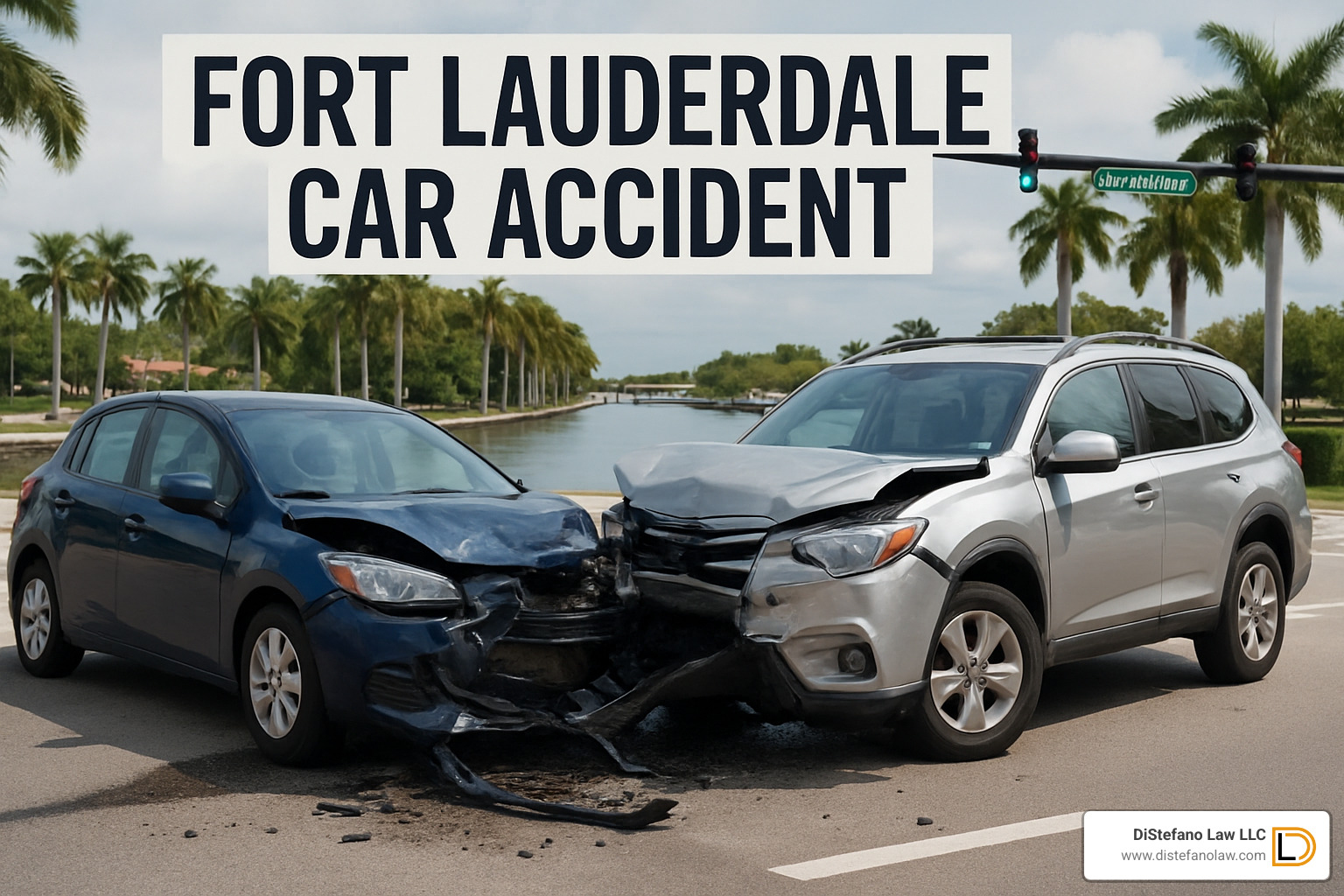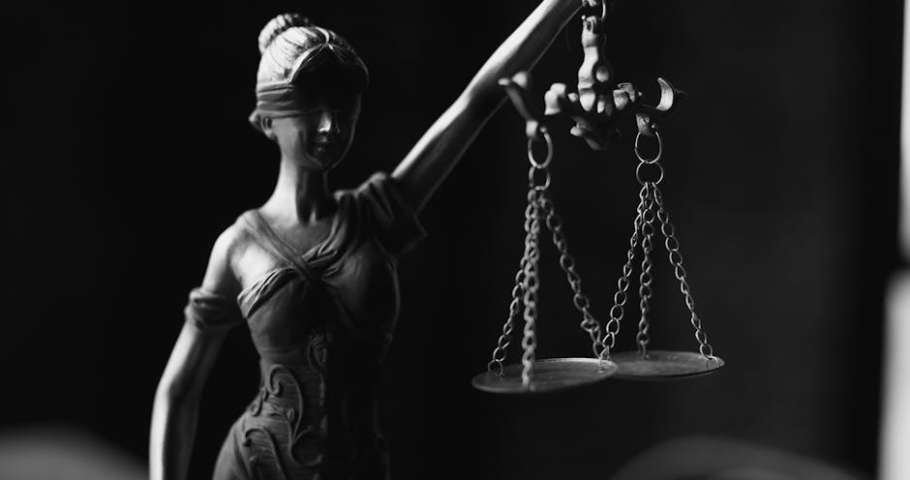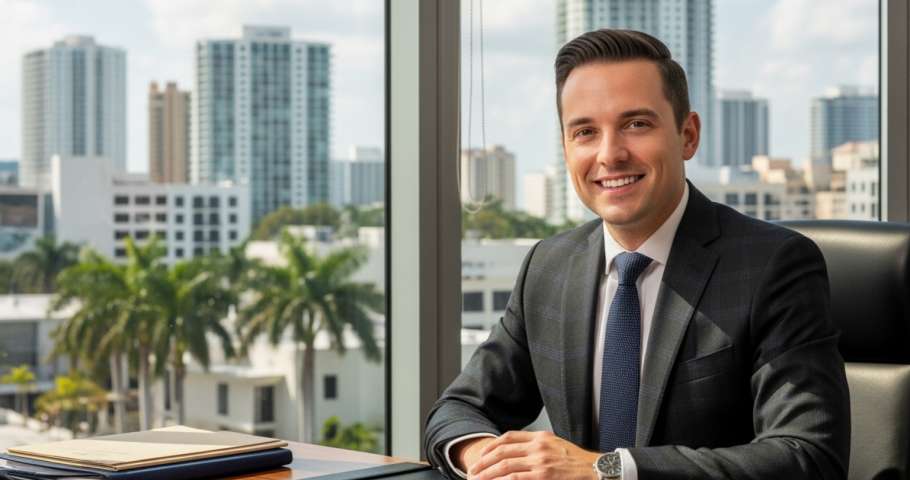The Rising Toll of Fort Lauderdale Roads
Fort Lauderdale car accidents have become an increasingly concerning reality for residents and visitors alike. If you’re looking for quick information about recent accidents in the area, here’s what you need to know:
| Fort Lauderdale Car Accident Quick Facts | Details |
|---|---|
| Annual Crashes in Broward County | 41,000+ |
| Injuries per Year | 24,000+ |
| Fatalities per Year | 225+ |
| Most Dangerous Time | Daytime (65% of crashes) |
| Most Common Condition | Dry roads (89% of crashes) |
| Alcohol Involvement | 23% of fatal crashes |
| Pedestrian Fatality Rate | 2nd highest in nation |
Fort Lauderdale’s busy streets and highways see thousands of collisions each year, with dramatic consequences for those involved. The impact extends far beyond damaged vehicles—medical bills, lost wages, and the emotional trauma of an unexpected crash can be overwhelming.
Recent data shows that Broward County consistently records over 41,000 car accidents annually, resulting in more than 24,000 injuries and 225 fatalities. Fort Lauderdale alone reported more than 10,000 crashes in a single year—more than several smaller Florida counties combined.
The risk increases substantially during tourist season and spring break when unfamiliar drivers steer local roads. Even more concerning is Fort Lauderdale’s distinction as having the second highest pedestrian fatality rate in the nation, with an average of 20 pedestrian deaths per year.
“Car accidents can take victims by surprise—one moment you’re driving, the next you’re facing life-altering injuries and mounting bills,” notes a local traffic safety advocate.
Whether you’re a longtime resident or just visiting, understanding the risks and knowing what to do after a crash can make all the difference in your recovery and legal options.

Crash Stats & Emerging Trends
The numbers behind Fort Lauderdale car accidents paint a troubling picture of our local roadways. Broward County consistently logs over 41,000 crashes each year, with Fort Lauderdale making up nearly a quarter of these incidents. In a single year, these accidents led to 24,762 injuries and 225 fatalities, according to data from the Florida Department of Highway Safety and Motor Vehicles.
What’s particularly worrying is how quickly these numbers have climbed. Between 2014 and 2016, Broward County saw crashes jump from 34,833 to over 41,000—nearly an 18% increase in just two years. This growth isn’t simply due to more people moving here; other factors are clearly at play.
When we look at when and where these accidents happen, some interesting patterns emerge. About 65% of Fort Lauderdale car accidents occur in broad daylight, and surprisingly, 89% happen on perfectly dry roads. Most crashes (82%) take place away from intersections, and alcohol plays a role in 23% of traffic deaths—a sobering reminder of how preventable many accidents truly are.
Fort Lauderdale’s unique seasonal rhythm strongly influences our crash patterns. From November through May—when snowbirds and tourists flock to our sunny shores—accident rates climb significantly. Spring break brings another spike, with many visitors navigating unfamiliar roads and traffic patterns.
Need to know what’s happening on the roads right now? The Florida Department of Transportation provides live traffic information that can help you avoid trouble spots during your commute.
| Year | Broward County Crashes | Injuries | Fatalities |
|---|---|---|---|
| 2014 | 34,833 | ~21,000 | ~200 |
| 2015 | 38,409 | ~23,000 | ~210 |
| 2016 | 41,000+ | ~24,000 | ~220 |
| 2017 | 41,337 | 24,762 | 225 |
| 2018 (Jan-Aug) | 22,266 | ~13,500 | ~130 |
| 2019 | 41,114 | 23,671 | 214 |
Fort Lauderdale car accident numbers in 2024 so far
While we’re still gathering complete data for 2024, early signs suggest Fort Lauderdale car accidents remain a serious concern for our community. The I-95 corridor continues to be a magnet for collisions, especially during those hectic morning and evening rush hours when everyone’s trying to get somewhere fast. The Sawgrass Expressway has also seen its fair share of incidents, particularly around major interchanges where traffic patterns get complicated.
Month by month, we’re seeing our typical South Florida pattern: higher accident rates during winter tourist season (January-March), a brief respite in late spring, and another uptick during summer vacation periods. It’s the perfect storm when you mix local commuters, tourists unfamiliar with our roads, and seasonal residents all navigating the same streets.
Some recent notable incidents include a dramatic submerged vehicle rescue near the Southwest Fourth Avenue/Avenue of the Arts drawbridge, multiple severe T-bone collisions along West Sunrise Boulevard, several serious motorcycle crashes on major thoroughfares, and sadly, pedestrian incidents in our busy downtown and beach areas.
Fort Lauderdale’s year-round population of approximately 185,000 swells dramatically during peak seasons, putting enormous pressure on our infrastructure. This constant ebb and flow of people contributes significantly to our persistently high accident rates as roads designed for residents must suddenly accommodate thousands of visitors.
Common Causes & Most Dangerous Spots in the City
When it comes to Fort Lauderdale car accidents, understanding the “why” behind these crashes can help you stay safe on our busy roads. Behind every statistic is a real story – perhaps a distracted driver glancing at their phone, a tourist unfamiliar with local roads, or someone who had one drink too many before getting behind the wheel.
Despite Florida’s 2019 texting-while-driving ban, distracted driving remains one of the leading causes of accidents in our city. We’ve all seen it – drivers scrolling through phones at red lights, then continuing the habit when traffic starts moving again. This momentary inattention can have devastating consequences.
Fort Lauderdale’s wide, inviting boulevards sometimes tempt drivers to test their vehicle’s limits. Speeding and aggressive driving behaviors like tailgating, sudden lane changes without signaling, and road rage incidents regularly contribute to serious crashes throughout the city.
The connection between our vibrant nightlife and impaired driving is impossible to ignore. With alcohol involved in 23% of traffic fatalities, it’s clear that despite rideshare options and public awareness campaigns, too many people still make the deadly choice to drive under the influence.
While most crashes (89%) occur on dry roads, our famous Florida downpours create instant hazards. When those tropical storms hit suddenly, visibility plummets and roads become slick – a dangerous combination even for experienced drivers.
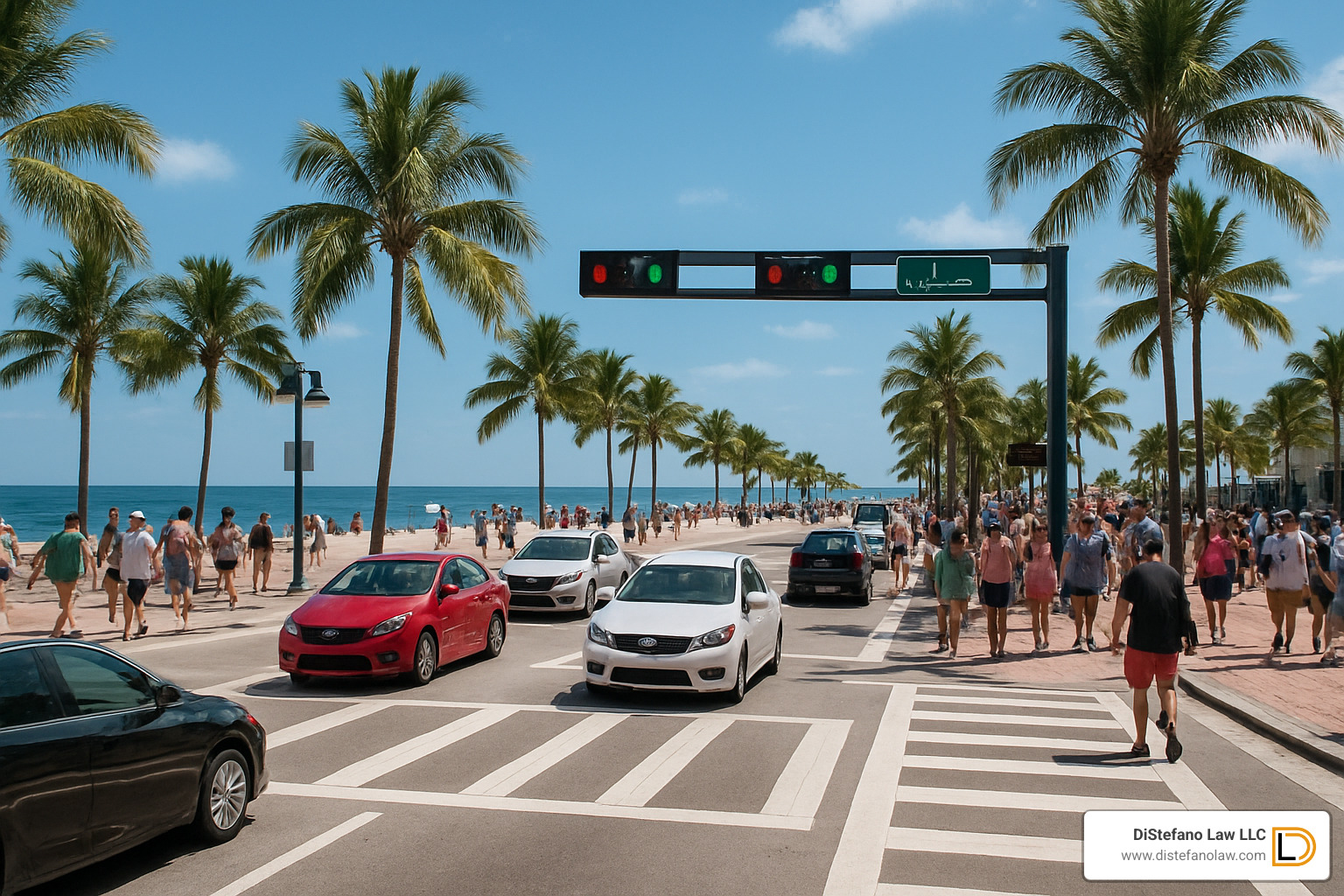
Some intersections and roadways in Fort Lauderdale have earned notorious reputations as accident magnets. A1A & Las Olas Boulevard tops the list, where hundreds of injury crashes occur annually. This beach-area intersection creates a perfect storm of confused tourists, distracted pedestrians, and drivers unfamiliar with local traffic patterns.
Sunrise Boulevard – especially around the 2400 block – has seen multiple serious T-bone collisions resulting in trauma-level injuries. The high speeds and complex traffic patterns here create particularly dangerous conditions.
The I-95 exit ramps throughout Fort Lauderdale have witnessed numerous fatal crashes, with the Cypress Creek Road exits being particularly problematic. Drivers often maintain highway speeds too long before attempting to steer these exits.
Broward Boulevard, as a major east-west corridor, experiences a high volume of crashes, particularly during morning and evening rush hours when commuter patience wears thin and aggressive driving increases.
Federal Highway (US-1) rounds out our top five danger zones, where numerous business entrances and exits create constant conflict points as vehicles merge into fast-moving traffic.
For more detailed information about vehicle accidents and your legal rights, our team has compiled resources at Automobile Accidents.
Why these Fort Lauderdale car accident hotspots keep seeing crashes
What makes these locations persistently dangerous? It’s not just bad luck – specific factors create these accident-prone environments.
Tourist confusion plays a significant role, especially near our beautiful beaches and hotel districts. Imagine navigating an unfamiliar city while trying to follow GPS directions, locate a hidden parking spot, and take in the sights – it’s a recipe for distracted driving. Visitors often make last-minute turns or lane changes when they spot their destination, creating hazards for everyone around them.
Fort Lauderdale’s ongoing change means construction zones are practically permanent fixtures on our roadways. These areas create temporary lane shifts, detours, and unexpected traffic patterns that can confuse even longtime residents. When orange cones appear, accident rates typically follow.
The pedestrian factor cannot be overlooked. Areas like Las Olas Boulevard and A1A feature a constant stream of people on foot, sometimes crossing mid-block rather than at designated crosswalks. This creates numerous conflict points between vehicles and vulnerable pedestrians, especially at night when visibility is reduced.
Some of our busiest intersections feature complicated traffic patterns that seem designed to confuse. Multiple turn lanes, lane shifts, and sometimes contradictory signage can lead even careful drivers to make mistakes. When you add in the pressure of impatient drivers behind you, the risk increases substantially.
The seasonal nature of our population creates unique challenges. During peak tourist seasons, our roads designed for 185,000 residents suddenly must accommodate hundreds of thousands more. This dramatic increase in traffic volume leads to congestion, frustration, and ultimately, more aggressive driving behaviors and higher accident rates.
What To Do Immediately After a Fort Lauderdale Car Accident
The chaotic moments after a Fort Lauderdale car accident can feel overwhelming, but what you do during this critical time matters tremendously. Taking the right steps now protects not just your health, but your legal rights and financial future too.
First things first—call 911 right away. Florida law requires reporting accidents involving injuries, deaths, hit-and-runs, DUI situations, vehicles needing tows, or property damage of $500+. Even in what seems like a minor fender-bender, it’s better to have the official documentation.
Don’t skip medical attention, even if you feel perfectly fine. Many injuries—especially whiplash or internal trauma—don’t show symptoms immediately. Florida’s PIP insurance has a strict 14-day rule: if you don’t see a doctor within two weeks of your accident, you might lose your benefits entirely.
Your phone can be your best ally at an accident scene. Take plenty of photos and videos of everything: damaged vehicles, the entire accident scene, road conditions, nearby traffic signs, your visible injuries, and license plates. This visual evidence often proves invaluable later when memories fade.
While you’re at the scene, gather contact information from anyone who witnessed what happened. Their perspective might make all the difference in establishing what really occurred. And of course, exchange information with the other driver—their name, contact details, insurance information, driver’s license number, and vehicle information.
Be sure to request a copy of the police report, which serves as the official record of what happened. For minor accidents where police don’t respond, you can still file using Florida’s self-reporting option.
Watch what you say at the accident scene. A simple “I’m sorry” might feel like basic human kindness, but insurance companies can interpret it as admitting fault. Similarly, resist the urge to post accident details or photos on social media—insurance adjusters routinely monitor these platforms and might use your posts against you.
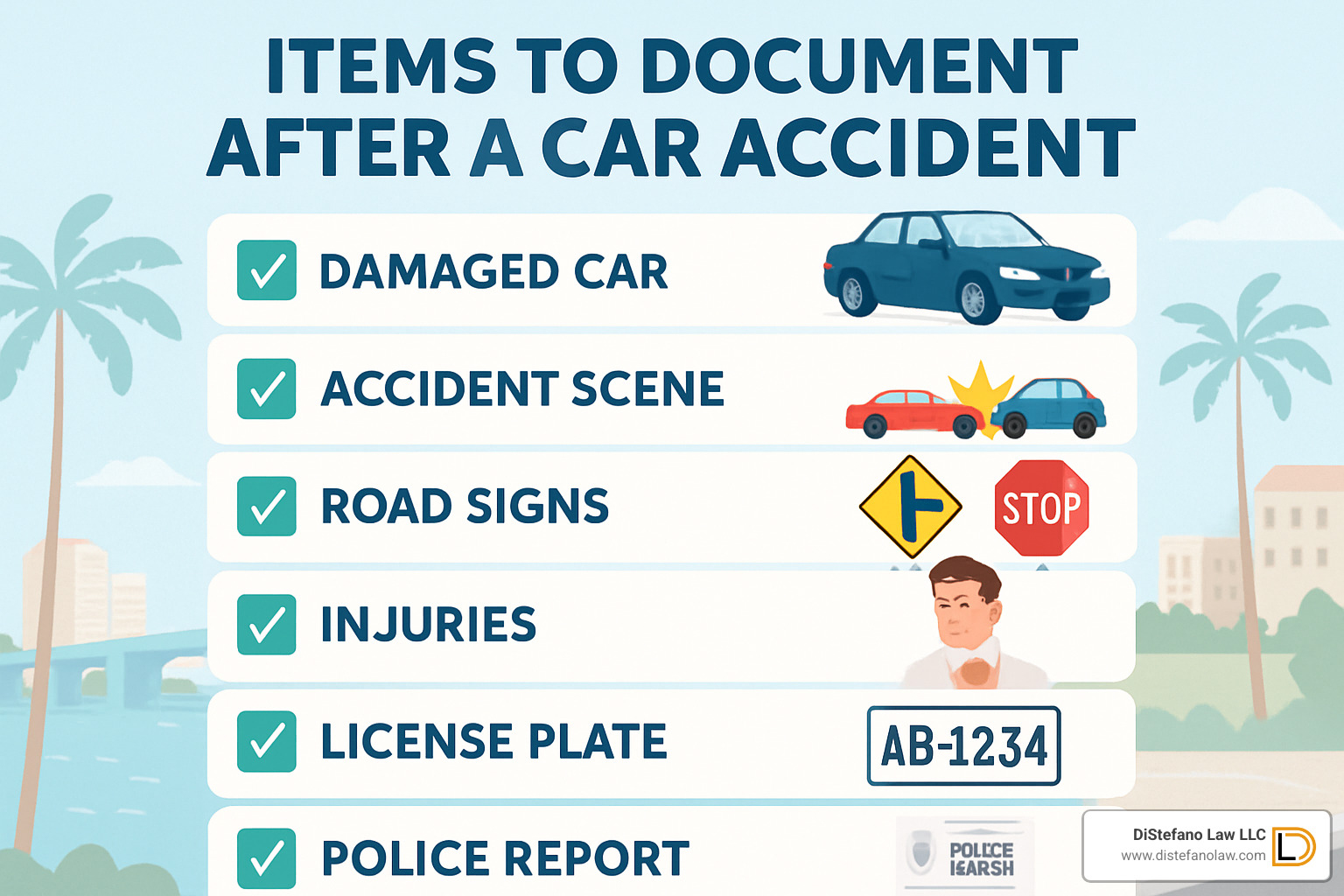
If you’ve been involved in a pedestrian or bicycle accident, the considerations are somewhat different. Visit our Pedestrian Accidents or Bicycle Accidents pages for specialized guidance.
Step-by-step guide for drivers
As the driver in a Fort Lauderdale car accident, a few additional steps can protect you and strengthen your position:
Safety comes first—if your vehicle isn’t severely damaged and is creating a traffic hazard, carefully move it to the shoulder or a nearby parking lot. Turn on those hazard lights to alert other drivers. But before moving anything, try to capture photos of the vehicles’ original positions if it’s safe to do so.
Contact your insurance company promptly, but keep your report factual and brief. This isn’t the time to offer detailed explanations or accept blame for what happened.
Your recovery journey matters, so keep a simple pain journal documenting your injuries, treatments, and how they’re affecting your daily life. Follow through with all medical appointments—gaps in your treatment history can seriously undermine your claim later.
Get a written estimate for your vehicle repairs from a reputable shop, and consider consulting with an attorney if you’re dealing with injuries, significant property damage, or any disputes about who caused the accident. Professional legal guidance often makes a substantial difference in recovery outcomes.
Step-by-step guide for pedestrians & cyclists in a Fort Lauderdale car accident
Pedestrians and cyclists face unique—and often more severe—challenges after being struck by a vehicle. If you’ve been hit while walking or biking, your immediate priority is medical care. Without the protection of a vehicle around you, injuries tend to be more serious and require prompt attention.
Document everything about your safety measures at the time of the accident. Were you wearing a helmet or reflective clothing? Did your bike have lights? These details demonstrate your commitment to safety and can significantly impact your case.
Don’t discard damaged items—your cracked helmet, torn clothing, or damaged bicycle all serve as powerful evidence of the impact force you experienced. Similarly, gather contact information from witnesses, as their perspectives often differ meaningfully from those in typical car-versus-car accidents.
Understanding your insurance options becomes especially important. As a pedestrian or cyclist, you might be covered by your own PIP auto insurance (even though you weren’t in a car), the driver’s PIP insurance, your health insurance, or the driver’s bodily injury liability coverage.
Take detailed photos of the accident location, including crosswalks, bike lanes, traffic signals, or any visibility issues that might have contributed to the accident. With Fort Lauderdale’s unfortunately high rates of pedestrian and cyclist accidents, these details matter tremendously in establishing what happened and who bears responsibility.
Florida Laws & Insurance 101
Understanding Florida’s unique insurance and legal framework is essential after a Fort Lauderdale car accident. Think of it as learning the rules of a game you never wanted to play – but now must understand to protect yourself.
Florida operates under a no-fault insurance system, which means your own Personal Injury Protection (PIP) insurance covers your initial expenses regardless of who caused the crash. Your PIP coverage handles 80% of your medical expenses and 60% of lost wages, up to $10,000. But here’s the catch – you must seek medical treatment within 14 days of the accident to qualify for these benefits. Miss this window, and you could lose your coverage entirely. And if you don’t receive emergency medical care initially, your PIP benefits might be limited to just $2,500.
“The 14-day rule catches many people by surprise,” says a local insurance expert. “Even if you feel fine initially, some injuries take days to manifest. By then, it might be too late to qualify for benefits.”
For injuries that go beyond what PIP covers, Florida law allows you to pursue a claim against the at-fault driver – but only if your injury qualifies as “serious.” This means your injury must involve significant permanent loss of an important bodily function, a permanent injury within reasonable medical probability, significant scarring or disfigurement, or death.
When it comes to determining fault, Florida follows a pure comparative negligence system. This means you can recover damages even if you were partially responsible for the accident. Your compensation will simply be reduced by your percentage of fault. For example, if you’re found 30% responsible, you’ll receive 70% of your eligible damages. Even at 90% fault, you could still recover 10% of your damages – a more forgiving approach than many other states.
Be aware of these critical deadlines for filing claims:
– Personal injury claims: 2 years from the accident date (recently shortened from 4 years)
– Wrongful death claims: 2 years from the date of death
– Property damage claims: 4 years
Given Florida’s high rate of uninsured drivers, uninsured/underinsured motorist coverage is strongly recommended, though not required by law. This optional coverage protects you when the at-fault driver has insufficient or no insurance – a situation all too common on Fort Lauderdale roads.
For more information about Florida’s insurance requirements, visit the Florida Highway Safety and Motor Vehicles website.
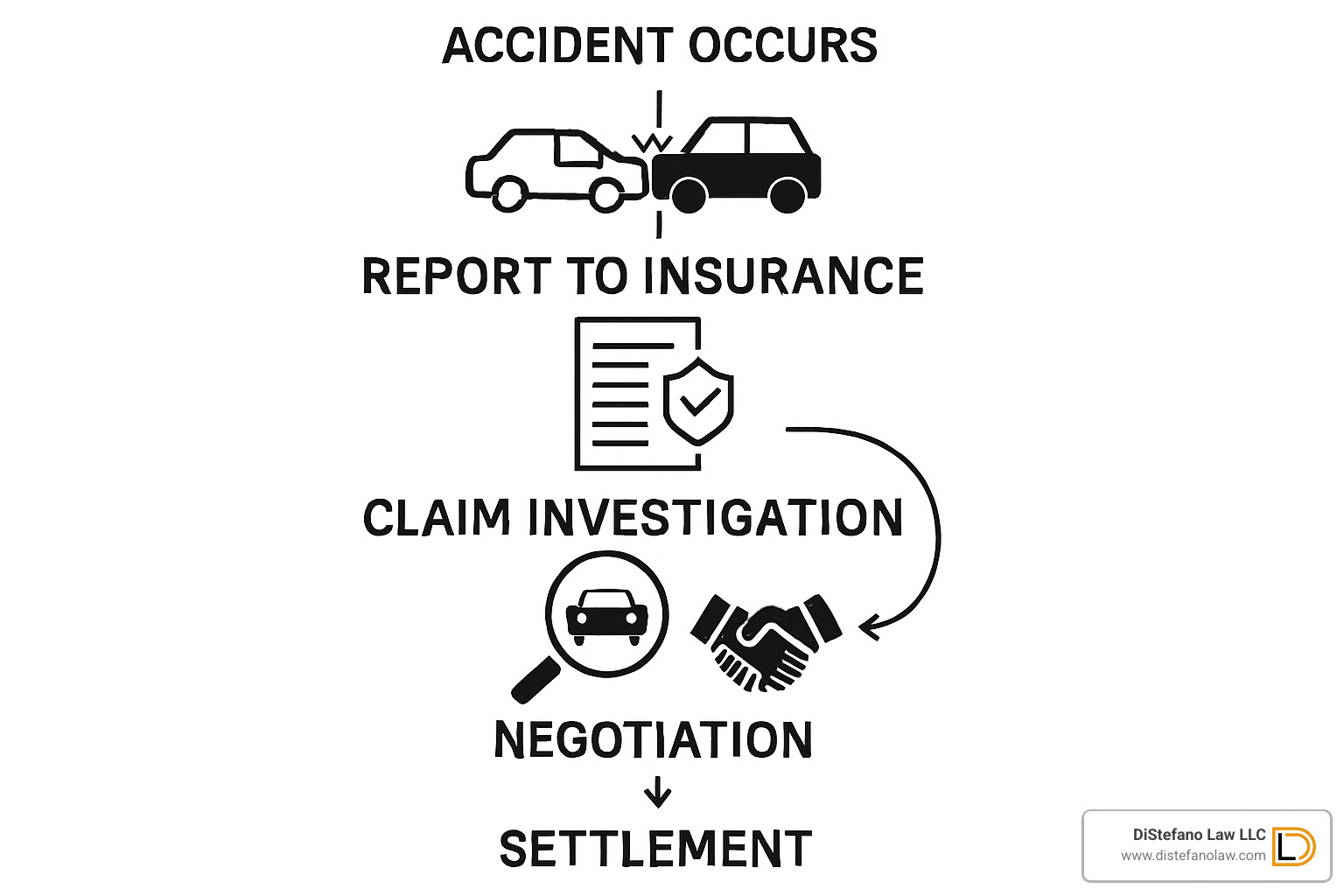
For more information about vehicle accidents in general, visit our Vehicle Accidents page.
Navigating insurance after a Fort Lauderdale car accident
After a Fort Lauderdale car accident, dealing with insurance companies can feel like navigating a maze blindfolded. Here’s your flashlight through the process:
Start by promptly notifying your own insurance company about the accident. They’ll provide forms for your PIP claim that typically request accident details, information about your medical providers, and employment documentation if you’re claiming lost wages.
When your injuries meet the serious injury threshold, you may also file a claim with the at-fault driver’s insurance. Be prepared for them to request a recorded statement – consider having an attorney present for this conversation. They’ll also ask for medical authorization forms, but be cautious about signing blanket authorizations that give them access to your entire medical history.
Once you’ve completed treatment or reached maximum medical improvement, a formal demand letter can be sent outlining your damages and requested compensation. This begins the negotiation dance.
Insurance adjusters have one primary goal: minimizing what their company pays you. Their initial offers are typically just conversation starters – often far below what your case is worth. Expect them to question whether your injuries existed before the accident, challenge the necessity of your treatments, and try to minimize the impact of your pain and suffering.
When evaluating settlement offers, think beyond your current situation. Consider future medical needs, ongoing pain and limitations, potential lost earning capacity, and whether the offer truly compensates all your damages. Accepting a settlement means signing away your right to seek additional compensation later – even if your condition worsens.
“Insurance companies count on people being in financial distress after an accident,” notes a local attorney. “They know offering quick cash to someone with mounting bills can be tempting, even if the amount doesn’t come close to covering long-term needs.”
Statute of limitations & fault rules every Fort Lauderdale car accident victim must know
The concept of negligence forms the backbone of Fort Lauderdale car accident cases. Proving negligence requires establishing four key elements: the driver had a duty of care (to operate their vehicle safely), they breached that duty (by texting, speeding, etc.), this breach directly caused the accident, and you suffered actual damages as a result.
Florida’s pure comparative negligence system has real dollars-and-cents implications for your case. If a jury awards you $100,000 but finds you were 20% at fault, your recovery would be reduced to $80,000. Even if you were mostly responsible – say 80% at fault – you could still recover $20,000. This system can be both a shield and a sword in negotiations, as both sides weigh how a jury might allocate blame.
The clock is ticking on your right to file a lawsuit after a crash. Florida recently shortened the statute of limitations for personal injury cases from four years to just two years from the accident date. This change makes quick action more important than ever. Wait too long, and you could permanently lose your right to compensation – regardless of how strong your case might be.
While certain exceptions can “toll” or pause this deadline – such as cases involving minors or injuries that weren’t immediately findable – these exceptions are limited and technical. The safest approach is always to consult with an attorney as soon as possible after a Fort Lauderdale car accident.
The legal landscape after an accident can be intimidating, but understanding these fundamental rules helps ensure you don’t accidentally forfeit valuable rights during what’s already a challenging time.
Injury Types, Damages & Settlement Process
The impact of a Fort Lauderdale car accident goes far beyond bent metal and broken glass. Real people suffer real injuries that can change lives in an instant.
Whiplash and neck injuries are among the most common aftermath of these crashes. Even what seems like a minor fender-bender can stretch and tear the delicate tissues in your neck, leaving you with pain and limited mobility that might last for months. More severe collisions often result in spinal cord damage – from herniated discs that cause chronic pain to catastrophic injuries leading to partial or complete paralysis.
Brain injuries represent another frightening possibility. A mild concussion might resolve in weeks, but more serious traumatic brain injuries (TBIs) can permanently alter your personality, cognitive abilities, and emotional regulation. As one recent client told us, “I feel like I’m living in someone else’s mind now.”
Fort Lauderdale car accidents frequently cause bone fractures requiring surgery, metal hardware, and months of painful physical therapy. Internal injuries to organs might not be immediately apparent but can become life-threatening without prompt treatment. And we should never overlook the psychological trauma – the nightmares, anxiety while driving, and PTSD that can linger long after physical wounds have healed.
When it comes to compensation, Florida law recognizes two primary categories of damages. Economic damages cover your actual financial losses – every medical bill, lost paycheck, property repair cost, and future care need. These are relatively straightforward to document, though projecting future medical expenses often requires expert testimony.
Non-economic damages address the human cost of your injuries – the pain that keeps you awake at night, the hobbies you can no longer enjoy, the strain on your marriage, and the emotional distress that follows trauma. While harder to quantify, these losses are just as real and compensable.
In the tragic case of fatal Fort Lauderdale car accidents, surviving family members may pursue wrongful death damages. These include funeral expenses and compensation for the lost financial support, companionship, and guidance the deceased would have provided.
Good news regarding taxation: most personal injury settlements aren’t taxable under federal law since they’re considered compensation for physical injuries. However, portions like punitive damages or interest may be taxable. For specific guidance, refer to IRS Publication 4345.
For more information about specific serious injuries, visit our Back & Spinal Cord Injuries and Head & Traumatic Brain Injury Lawyer pages.
How settlements & verdicts are decided in a Fort Lauderdale car accident case
What determines whether your Fort Lauderdale car accident case settles for $15,000 or $150,000? Several key factors come into play.
Your medical evidence forms the foundation of your claim. Clear diagnostic tests like MRIs showing a herniated disc carry more weight than subjective complaints of pain alone. Detailed physician notes documenting your limitations, consistent treatment records, and expert testimony about your future needs all strengthen your position.
The liability picture significantly impacts your recovery. Was the other driver clearly texting while running a red light, or is fault less clear-cut? Evidence establishing responsibility might include traffic camera footage, witness statements from people who saw the crash, expert accident reconstruction, police reports, and physical evidence from the scene like skid marks or the position of debris.
Insurance policy limits often create practical ceilings on recovery. If the at-fault driver carries only Florida’s minimum coverage, your compensation may be limited unless you have your own uninsured/underinsured motorist protection or the defendant has substantial personal assets.
The severity and permanence of your injuries naturally affect settlement values. A broken arm that heals completely typically results in lower compensation than a permanent back injury that prevents you from returning to your construction job.
Lost income must be thoroughly documented with pay stubs, tax returns, and employer statements. Future earning capacity losses—particularly for young victims with decades of work ahead—can substantially increase case values.
The skill of your representation matters tremendously. Insurance adjusters know which attorneys prepare thoroughly for trial versus those who quickly settle cases. This perception directly impacts initial settlement offers.
If your case reaches a jury, additional factors come into play—how credible and likable you appear as a witness, how clearly your doctors explain your injuries, and whether your account of the accident remains consistent throughout the proceedings.
In cases involving drunk drivers or other particularly reckless behavior, punitive damages may be available beyond your compensatory damages. These are specifically designed to punish wrongdoers and deter similar conduct.
While most cases settle before trial, approaching your case as if you’re headed to court often results in the most favorable settlement offers. After all, insurance companies are most generous when they fear what might happen in front of a jury.
When & Why to Call a Lawyer
The aftermath of a Fort Lauderdale car accident can be overwhelming. While minor fender-benders might be manageable on your own, many situations call for professional legal guidance. Having an experienced attorney by your side can make a world of difference in your recovery journey.
You should strongly consider legal representation if:
You’ve suffered serious injuries requiring extensive medical care, or if your accident resulted in permanent disability or disfigurement. These complex cases often involve substantial medical expenses and lifetime care needs that require expert valuation.
When a loved one has died in a crash, navigating Florida’s wrongful death laws during your time of grief becomes incredibly challenging without proper guidance. Similarly, cases with disputed fault, multiple potentially liable parties, or commercial vehicles involve layers of complexity best handled by professionals.
Dealing with uninsured or underinsured drivers presents unique challenges that an experienced attorney knows how to address. And if you’re facing insurance company tactics like delays, denials, or lowball offers, having an advocate who speaks their language is invaluable.

A good attorney brings much more than legal knowledge to your case. They’ll immediately work to preserve critical evidence before it disappears – traffic camera footage that might be deleted within days, witness statements while memories are fresh, and proper documentation of vehicle damage before repairs.
The resources a law firm can deploy make a significant difference too. Access to accident reconstruction specialists, medical experts, and economic analysts can transform your case by establishing clear liability and accurately calculating your full damages.
Perhaps most importantly, you can focus on healing while your attorney handles the stress of insurance negotiations. And with contingency fee arrangements, you’ll pay nothing upfront – legal fees come only from successful settlements or verdicts.
For more information or to discuss your situation in a free consultation, contact us today.
Red-flag mistakes that hurt your Fort Lauderdale car accident claim
Even the strongest cases can be undermined by common missteps after a Fort Lauderdale car accident. Being aware of these pitfalls can protect your right to fair compensation.
Delayed medical treatment sends the wrong message to insurance companies. When you wait days or weeks to see a doctor, adjusters quickly argue that your injuries couldn’t have been serious or weren’t caused by the accident. Always seek medical attention promptly, even if you think your injuries are minor.
Talking too freely can seriously damage your case. Giving recorded statements without legal guidance often leads to innocent comments being twisted against you. Similarly, signing broad medical authorizations gives insurers access to your entire health history, which they’ll comb through looking for any previous complaints they can blame for your current pain.
That quick settlement offer might seem tempting when bills are piling up, but accepting early offers almost always means leaving significant money on the table. Initial offers rarely account for long-term medical needs, future lost income, or ongoing pain and suffering.
In today’s connected world, social media posts have become a goldmine for insurance investigators. That innocent photo of you smiling at a family gathering can be used to suggest you’re not really suffering, even if you were in terrible pain when the picture was taken.
Skipping medical appointments or ignoring doctor recommendations undermines your credibility and suggests you’re not truly injured. And while it might seem harmless, discussing your case with friends and family can create problematic witnesses if their understanding of your situation differs from yours.
Benefits & costs of hiring counsel after a Fort Lauderdale car accident
Making the decision to hire an attorney after a Fort Lauderdale car accident involves understanding both the advantages and the financial aspects of legal representation.
The benefits are substantial and well-documented. Studies consistently show that represented clients typically receive settlements 3-4 times higher than those handling claims on their own, even after attorney fees are paid. This dramatic difference exists because experienced attorneys understand the true value of your claim and know how to document and prove all eligible damages.
Beyond just dollars and cents, the peace of mind that comes with professional representation is invaluable. Your attorney becomes a buffer between you and persistent insurance adjusters, handling all communications while you focus on what matters most – your recovery. They ensure all deadlines are met, paperwork is properly filed, and no potential sources of compensation are overlooked.
When it comes to costs, the contingency fee structure used by most personal injury attorneys, including our team, makes quality legal representation accessible to everyone. You’ll pay nothing upfront, and attorney fees (typically ranging from 33-40% depending on case complexity) come only from successful settlements or verdicts. Case expenses for things like medical records, expert witnesses, and filing fees are usually advanced by the firm and later reimbursed from your settlement.
The beauty of this arrangement is simple – if there’s no recovery, you typically owe nothing for attorney fees. This aligns your attorney’s interests perfectly with yours – they only succeed when you do.
Most reputable firms offer free consultations where you can discuss your case without obligation. This meeting gives you the opportunity to ask about the attorney’s experience with similar cases, understand your claim’s strengths and weaknesses, learn about the legal process ahead, and determine if the attorney feels like the right fit for your needs.
Frequently Asked Questions about Fort Lauderdale Car Accidents
How often do crashes happen in Fort Lauderdale and Broward County?
The reality of Fort Lauderdale car accidents is startling when you look at the numbers. Every single day, about 27 accidents happen on Fort Lauderdale streets alone – that’s more than one crash every hour of every day.
Broward County sees over 41,000 crashes annually, with Fort Lauderdale accounting for roughly 10,000 of those incidents. What’s particularly troubling is how disproportionate these numbers are relative to our population. With just 185,000 residents, Fort Lauderdale experiences more crashes than several smaller Florida counties combined. And that’s before we even factor in the millions of tourists who visit our sunny shores each year.
The human toll is equally sobering. These accidents result in approximately 24,000 injuries and 225 fatalities countywide annually. To put that in perspective, our fatality rate of 22.39 deaths per 100,000 people significantly exceeds the national average – a statistic that reminds us how crucial road safety is in our community.
What evidence is most important to collect right after a crash?
Those first moments after a Fort Lauderdale car accident can feel overwhelming, but gathering evidence is crucial for protecting your rights. Think of it as creating a time capsule of the accident scene – once it’s gone, you can’t go back.
Photographs and videos serve as your most powerful tools. Capture everything: vehicle damage from multiple angles, the entire accident scene, road conditions, traffic signals, and any visible injuries. These visual records often speak louder than words when dealing with insurance companies.
The police report provides an official account of what happened. Even in minor accidents, having this document can make a significant difference in establishing the facts. Similarly, independent witness statements offer unbiased perspectives that can support your version of events – be sure to collect contact information from anyone who saw what happened.
Your medical records create the critical link between the accident and your injuries. This is why seeking immediate medical attention matters, even if you feel “just a little sore.” Some injuries take days to fully manifest, but that initial medical visit establishes the timeline.
Time-sensitive evidence like surveillance footage from nearby businesses or traffic cameras must be requested quickly before it’s deleted. Physical evidence at the scene – skid marks, debris patterns, damage to roadside structures – and electronic data from modern vehicles can help reconstruct exactly what happened.
Evidence tends to disappear quickly. The sooner you gather it (or have an attorney help you gather it), the stronger your case will be.
Are my settlement proceeds taxable in Florida?
When it comes to taxes on your Fort Lauderdale car accident settlement, the answer isn’t simple, but there’s good news for Florida residents.
First, the positive side: Florida has no state income tax, so you won’t pay state taxes on any portion of your settlement. That’s one financial worry you can cross off your list.
For federal taxes, what matters is what the money is compensating you for. Generally, compensation for physical injuries or physical sickness isn’t taxable. This includes medical expense reimbursements (as long as you didn’t previously deduct these expenses on your taxes) and property damage recovery (unless it exceeds your property’s adjusted basis). Even emotional distress damages resulting directly from physical injury typically remain tax-free.
However, some portions of your settlement might still be taxable federally. Punitive damages – designed to punish particularly bad behavior – generally can’t escape the tax man. The same goes for interest on your settlement, compensation for lost wages, and emotional distress damages not tied to physical injury.
If you previously deducted medical expenses on your taxes and then received compensation for those same expenses, that portion might also be taxable.
For personalized guidance on your specific situation, it’s worth consulting with a tax professional. The IRS Publication 4345, “Settlements — Taxability,” also provides helpful information that can clarify your particular circumstances.
Conclusion
The aftermath of a Fort Lauderdale car accident can feel like navigating a maze without a map. From medical appointments to insurance paperwork, the challenges can seem endless when you’re already dealing with pain and recovery.
Throughout this guide, we’ve walked through the essential steps to protect yourself and your future after a crash. Now, let’s bring it all together with a clear path forward.
Your health should always come first. Even if you feel “fine” after an accident, some injuries take days or weeks to fully reveal themselves. That quick medical check-up isn’t just for your wellbeing—it creates an official record connecting your injuries to the accident, which becomes invaluable for your claim.
Documentation becomes your strongest ally. Those photos you took at the scene, the witness statements you collected, the police report, your medical records—they all tell the story of what happened and how it’s affected your life. Keep everything organized and accessible.
Florida’s unique insurance laws create a landscape that’s different from many other states. Understanding the no-fault system, PIP coverage limitations, and the recent change to a two-year statute of limitations can make the difference between fair compensation and no compensation at all.
Insurance adjusters, no matter how friendly, have one primary goal: to save their company money. Every statement you make, form you sign, or offer you accept has consequences. Proceed with caution and consider getting professional advice before making major decisions.
Speaking of professional guidance—there’s a reason accident victims who hire attorneys typically receive significantly higher settlements. The legal system is complex by design, and having someone who speaks its language can transform your experience and outcome.
At DiStefano Law LLC, we’ve spent over four decades helping Fort Lauderdale residents rebuild their lives after serious accidents. We understand the physical, emotional, and financial toll these events take on victims and their families across South Florida—from Lauderhill to Wilton Manors, from Sunrise to the beaches.
The roads in our beautiful city present real dangers every day. But should the unexpected happen, you don’t have to face the aftermath alone. With the right knowledge, careful documentation, and experienced representation, you can focus on healing while we handle the complexities of your case.
For more information about our approach to personal injury cases, visit our Personal Injury services page or reach out for a free consultation. We work on a contingency basis—if we don’t win your case, you don’t pay a fee.
Stay safe out there, Fort Lauderdale. And remember, if you ever need help after an accident, we’re just a phone call away.


